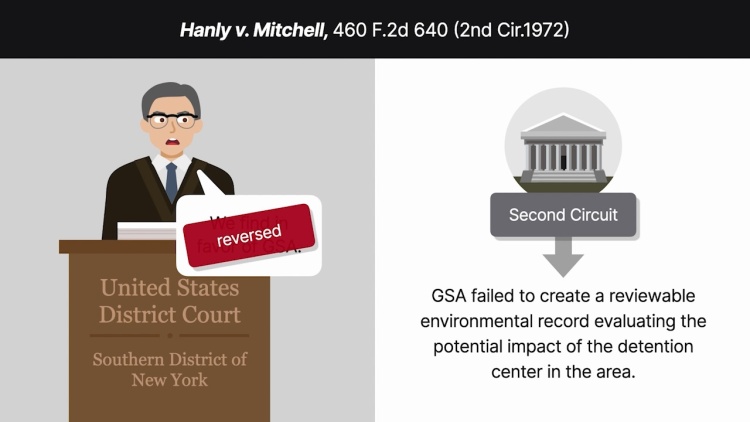Hanly v. Kleindienst
United States Court of Appeals for the Second Circuit
471 F.2d 823 (1972)
- Written by Craig Conway, LLM
Facts
Denis Hanly and other residents and businesses in New York City (plaintiffs) filed suit in federal court against Richard Kleindienst, in his official capacity as Attorney General of the United States, and others (defendants) to halt construction of a neighboring 12-story annex to the U.S. Courthouse building consisting of an office center and detention center that would house about 450 criminal defendants awaiting trial or serving short-term federal sentences. Plaintiffs alleged the General Services Administration (GSA) failed to issue an Environmental Impact Statement (EIS) required by the National Environmental Policy Act (NEPA) prior to approving the project. The district court disagreed that an EIS was needed and held for defendants. See Hanly v. Mitchell, 460 F.2d 640 (2nd Cir.1972) (Hanley I). On appeal, the court of appeals affirmed the district court’s judgment as it related to the office center, but reversed and remanded as to the detention center on the ground that the GSA did not fully investigate the possible environmental impacts of the prison, including any increase in noise pollution, traffic, and crime in the area. In response, the GSA prepared a 25-page “Assessment of the Environmental Impact” which concluded the detention center would not have any significant environmental effect on the environment. Based on the report, the district court again denied plaintiffs’ request for an injunction. Plaintiffs appealed.
Rule of Law
Issue
Holding and Reasoning (Mansfield, J.)
Dissent (Friendly, C.J.)
What to do next…
Here's why 899,000 law students have relied on our case briefs:
- Written by law professors and practitioners, not other law students. 47,000 briefs, keyed to 994 casebooks. Top-notch customer support.
- The right amount of information, includes the facts, issues, rule of law, holding and reasoning, and any concurrences and dissents.
- Access in your classes, works on your mobile and tablet. Massive library of related video lessons and high quality multiple-choice questions.
- Easy to use, uniform format for every case brief. Written in plain English, not in legalese. Our briefs summarize and simplify; they don’t just repeat the court’s language.





